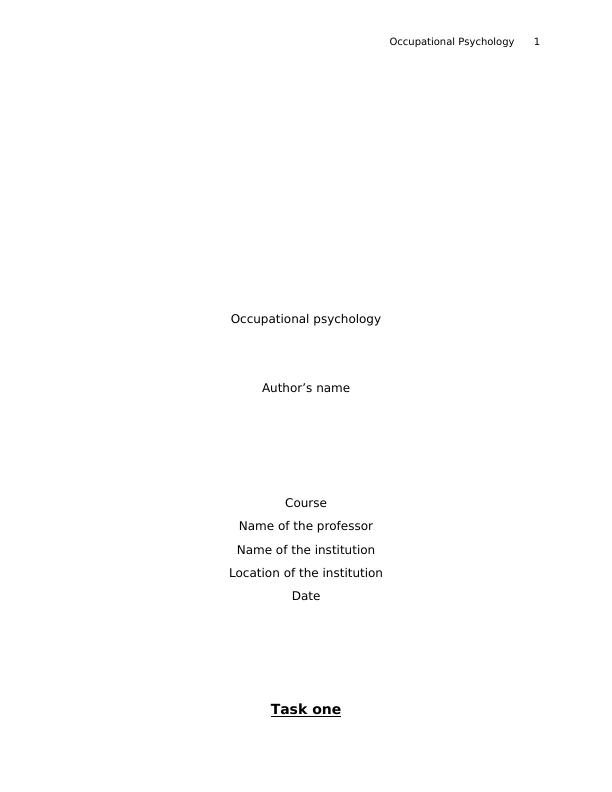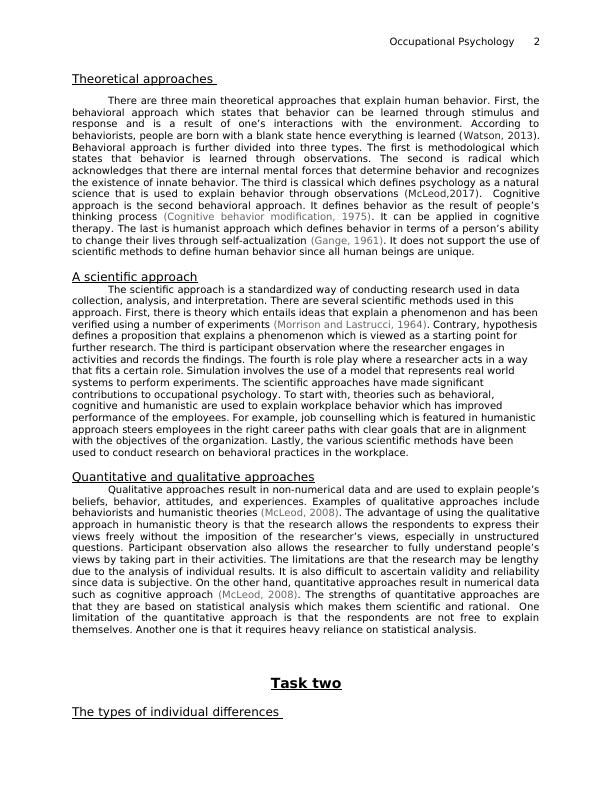Occupational Psychology: Assignment
7 Pages3208 Words71 Views
Added on 2020-04-01
Occupational Psychology: Assignment
Added on 2020-04-01
ShareRelated Documents
Occupational Psychology 1Occupational psychology Author’s name Course Name of the professorName of the institutionLocation of the institutionDate Task one

Occupational Psychology 2Theoretical approaches There are three main theoretical approaches that explain human behavior. First, thebehavioral approach which states that behavior can be learned through stimulus andresponse and is a result of one’s interactions with the environment. According tobehaviorists, people are born with a blank state hence everything is learned (Watson, 2013).Behavioral approach is further divided into three types. The first is methodological whichstates that behavior is learned through observations. The second is radical whichacknowledges that there are internal mental forces that determine behavior and recognizesthe existence of innate behavior. The third is classical which defines psychology as a naturalscience that is used to explain behavior through observations (McLeod,2017). Cognitiveapproach is the second behavioral approach. It defines behavior as the result of people’sthinking process (Cognitive behavior modification, 1975). It can be applied in cognitivetherapy. The last is humanist approach which defines behavior in terms of a person’s abilityto change their lives through self-actualization (Gange, 1961). It does not support the use ofscientific methods to define human behavior since all human beings are unique. A scientific approachThe scientific approach is a standardized way of conducting research used in data collection, analysis, and interpretation. There are several scientific methods used in this approach. First, there is theory which entails ideas that explain a phenomenon and has beenverified using a number of experiments (Morrison and Lastrucci, 1964). Contrary, hypothesisdefines a proposition that explains a phenomenon which is viewed as a starting point for further research. The third is participant observation where the researcher engages in activities and records the findings. The fourth is role play where a researcher acts in a way that fits a certain role. Simulation involves the use of a model that represents real world systems to perform experiments. The scientific approaches have made significant contributions to occupational psychology. To start with, theories such as behavioral, cognitive and humanistic are used to explain workplace behavior which has improved performance of the employees. For example, job counselling which is featured in humanistic approach steers employees in the right career paths with clear goals that are in alignment with the objectives of the organization. Lastly, the various scientific methods have been used to conduct research on behavioral practices in the workplace.Quantitative and qualitative approachesQualitative approaches result in non-numerical data and are used to explain people’sbeliefs, behavior, attitudes, and experiences. Examples of qualitative approaches includebehaviorists and humanistic theories (McLeod, 2008). The advantage of using the qualitativeapproach in humanistic theory is that the research allows the respondents to express theirviews freely without the imposition of the researcher’s views, especially in unstructuredquestions. Participant observation also allows the researcher to fully understand people’sviews by taking part in their activities. The limitations are that the research may be lengthydue to the analysis of individual results. It is also difficult to ascertain validity and reliabilitysince data is subjective. On the other hand, quantitative approaches result in numerical datasuch as cognitive approach (McLeod, 2008). The strengths of quantitative approaches arethat they are based on statistical analysis which makes them scientific and rational. Onelimitation of the quantitative approach is that the respondents are not free to explainthemselves. Another one is that it requires heavy reliance on statistical analysis. Task twoThe types of individual differences

Occupational Psychology 3Intelligence quotient (IQ) is the measure of a person’s intelligence which is theirmental age divided by their age multiplied by a hundred. Intelligence can be defined as theability to do something (Checa and Fernández-Berrocal, 2015). It can be expressed in manyways such as being good in sports and getting good grades. Intelligence tests can beindividual or group. On the other hand, aptitude is the capability of an individual to performa certain task. Aptitude tests indicate whether someone can be successful in doingsomething after training. Some tests that are used are Differential Aptitude Tests. Another isEmotional quotient(EQ) which is the ability to recognize and use emotional acumen to attainsomething. It defines the ability to understand other people’s emotions and be able to workwith them (Checa and Fernández-Berrocal, 2015). An example is the Daniel Golemanemotional intelligence test. Personality is that behavior of a person that remains constantover a period of time (Personality and individual differences, 1997). There are three ways ofassessing personality. The first is self-report measures where an individual is asked abouthimself or herself through a questionnaire. An example is the Sixteen Personality FactorQuestionnaire. The second is indirect measures that refer to questions that are unstructuredhence individuals show their unconscious feelings. An example is the Rorschach Ink BlotTest. The third is the observation measures where an individual is observed in a certainsituation. An example is the Situational Stress Test. The last is memory, where individuals’ability to retain information is tested. This has led to working memory which refers to shortterm memory (McLeod, 2008). Working memory is used in activities such as reading andreasoning. Usefulness of psychometric instruments Psychometric tests refer to tests that measure differences between individuals based on factors such as ability, intelligence, and attitude. For example, Myers-Briggs Type Indicator and the Factor Five Model (Psychometric tests, 2002). A reliable Psychometric instrument is one that shows consistency when done during different time periods. For instance, if one takes the Myers-Briggs Type Indicator today the results should be the same if the test is taken two weeks later. There are different types of reliability. Inter-rater reliability measures the degree that raters give consistent results for the same feature. Test retest reliability measures the degree of consistency between results from the same instrument on the same feature but on different periods. Finally, internal consistency refers to the consistency of results of items measured by an instrument. A valid psychometric instrument measures the degree that the instrument measures what is intended. For example, Myers-Briggs Type Indicator should measure a person’s personality type and predict what that person would do in different situations based on the personality. There are types of validity such as face, content, criteria, and construct (Psychometric tests, 2002). Face validity measures the degree that a test appears effective when compared to its aims. Content validity measures the extent that a test measures all aspects of a feature. The criterion validity refers to the degree that an instrument measure relates to the results. Lastly, construct validity measures the degree that an instrument measures what it is supposed to measure (Socialresearchmethods, n.d.). Measures of individual differences Business decisions are courses of actions that result when choices are made.Aptitude tests can be used to make business decisions. As mentioned earlier, aptitude testsmeasure the ability to perform tasks. When carried out by an organization during therecruitment process, it can determine which potential employee is a good fit for thecompany. Another example is during promotions, where an aptitude test can determine if anindividual is can take on more responsibility. Overall, organizations make the best decisionswhen it comes to the employees that fit their needs. The other difference is personality.Personality tests can also be administered during interview processes. For example, sales

End of preview
Want to access all the pages? Upload your documents or become a member.
Related Documents
Educational Theories and Its Applicationlg...
|6
|1429
|155
Psychology Assignment | Psychological Theorieslg...
|9
|2137
|369
Report On Business Occupational Psychologylg...
|16
|3985
|464
Psychological Approaches and Human Behaviorlg...
|6
|1501
|21
Psychology Research Paper 2022lg...
|10
|2614
|13
PSYCHOLOGY OF BEHAVIOUR TABLE OF CONTENTS INTRODUCTION 1 MAIN BODY1 P1. Description of psychological perspectives and effects on human behaviourlg...
|15
|3326
|429
